Abstract
Purpose
In recent years, proton magnetic resonance spectroscopy (MRS) has emerged as a non-invasive technique for measurement of fat content in the liver. The technique is often applied for overweight and obese patients. However, excessively obese patients cannot be examined in most conventional magnetic resonance systems due to limited space. The purpose of this study was to examine the ability of open 1T system to monitor liver fat with proton MRS and to compare hepatic fat fractions (HFFs) obtained using an open 1T system with assessment with 3T proton MRS.
Methods
The study included 23 children and adolescents up to 20 years of age with a body mass index above the 97th percentile according to age and gender. Proton MRS for each patient was performed in both 1T and 3T using point resolved spectroscopy sequence in a single volume positioned in the right liver lobe.
Results
Average T2 relaxation times obtained for an open 1T system (55 ± 7 ms for water and 85 ± 11 ms for fat) were higher than average T2 relaxation times obtained for a 3T system (31 ± 4 ms for water and 66 ± 10 ms for fat). HFFs measured using an open 1T system showed strong correlation with HFFs measured using a 3T system (r = 0.99, P < 0.0001).
Conclusions
Proton MRS measurements of HFF with an open 1T system are feasible. Open 1T system may reliably replace 3T magnetic resonance system for the assessment of liver fat.


Similar content being viewed by others
References
Harrison SA, Day CP (2007) Benefits of lifestyle modification in NAFLD. Gut 56:1760–1769
Bellentani S, Scaglioni F, Marino M, Bedogni G (2010) Epidemiology of non-alcoholic fatty liver disease. Dig Dis 28:155–161
Paradis V, Bedossa P (2008) Definition and natural history of metabolic steatosis: histology and cellular aspects. Diabetes Metab 34:638–642
Ma X, Holalkere NS, Kambadakone RA, et al. (2009) Imaging-based quantification of hepatic fat: methods and clinical applications. Radiographics 29:1253–1277
Patton HM, Lavine JE, Van Natta ML, et al. (2008) Clinical correlates of histopathology in pediatric nonalcoholic steatohepatitis. Gastroenterology 135:1961–1971
Wieckowska A, Feldstein AE (2008) Diagnosis of nonalcoholic fatty liver disease: invasive versus noninvasive. Semin Liver Dis 28:386–395
Radetti G, Kleon W, Stuefer J, Pittschieler K (2006) Non-alcoholic fatty liver disease in obese children evaluated by magnetic resonance imaging. Acta Paediatr 95:833–837
Fischbach F, Bruhn H (2008) Assessment of in vivo 1H magnetic resonance spectroscopy in the liver: a review. Liver Int 28:297–307
Chabanova E, Bille DS, Thisted E, Holm J-C, Thomsen HS (2012) MR spectroscopy of liver in overweight children and adolescents: investigation of 1H T2 relaxation times at 3T. Eur J Radiol 81:811–814
Reeder SB, Cruite I, Hamilton G, Sirlin CB (2011) Quantitative assessment of liver fat with magnetic resonance imaging and spectroscopy. J Magn Reson Imaging 34:729–749
Zhong L, Chen JJ, Chen J, et al. (2009) Non-alcoholic fatty liver disease: quantitative assessment of liver fat content by computed tomography, magnetic resonance imaging and proton magnetic resonance spectroscopy. J Dig Dis 10:315–320
Mehta SR, Louise Thomas E, Patel N, et al. (2010) Proton magnetic resonance spectroscopy and ultrasound for hepatic fat quantification. Hepatol Res 40:399–406
de Bucourt M, Streitparth F, Wonneberger U, Rump J, Teichgräber U (2011) Obese patients in an open MRI at 1.0 Tesla: image quality, diagnostic impact and feasibility. Eur Radiol 21:1004–1015
Holm JC, Gamborg M, Bille DS, et al. (2011) Chronic care treatment of obese children and adolescents. Int J Pediatr Obes 6:188–196
Nysom K, Molgaard C, Hutchings B, Michaelsen KF (2001) Body mass index of 0 to 45-y-old Danes: reference values and comparison with published European reference values. Int J Obes Relat Metab Disord 25:177–184
Ishizaka K, Oyama N, Mito S, et al. (2011) Comparison of 1H MR-spectroscopy, 3-point DIXON, and multi-echo gradient echo for measuring hepatic fat fraction. Magn Reson Med Sci 10:41–48
Hájek M, Dezortová M, Wagnerová D, et al. (2011) MR-spectroscopy as a tool for in vivo determination of steatosis in liver transplant recipients. MAGMA 24:297–304
Roldan-Valadez E, Favila R, Martínez-López M, et al. (2010) In vivo 3T spectroscopic quantification of liver fat content in non-alcoholic fatty liver disease: correlation with biochemical method and morphometry. J Hepatol 53:732–737
van Werven JR, Hoogduin JM, Nederveen AJ, et al. (2009) Reproducibility of 3.0 Tesla magnetic resonance spectroscopy for measuring hepatic fat content. J Magn Reson Imaging 30:444–448
Szczepaniak LS, Nurenberg P, Leonard D, et al. (2005) Magnetic resonance spectroscopy to measure hepatic triglyceride content: prevalence of hepatic steatosis in the general population. Am J Physiol Endocrinol Metab 288:E462–E468
van Werven JR, Schreuder TC, Nederveen AJ, et al. (2010) Hepatic unsaturated fatty acids in patients with non-alcoholic fatty liver disease assessed by 3.0T MR-spectroscopy. Eur J Radiol 75:e102–e107
Kotronen A, Peltonen M, Hakkarainen A, et al. (2009) Prediction of non-alcoholic fatty liver disease and liver fat using metabolic and genetic factors. Gastroenterology 137:865–872
Guiu B, Loffroy R, Petit JM, et al. (2009) Mapping of liver fat with triple-echo gradient echo imaging: validation against 3.0-T proton MR spectroscopy. Eur Radiol 19:1786–1793
Hamilton G, Middleton MS, Bydder M, et al. (2009) Effect of PRESS and STEAM sequences on magnetic resonance spectroscopic liver fat quantification. J Magn Reson Imaging 30:145–152
Bohte AE, Koot BG, van der Baan-Slootweg OH, et al. (2012) US cannot be used to predict the presence or severity of hepatic steatosis in severely obese adolescents. Radiology 262:327–334
van Werven JR, Schreuder TC, Aarts EO, et al. (2011) Hepatic steatosis in morbidly obese patients undergoing gastric bypass surgery: assessment with open-system 1H-MR-spectroscopy. Am J Roentgenol 196:W736–W742
de Bazelaire CM, Duhamel GD, Rofsky NM, Alsop DC (2004) MR imaging relaxation times of abdominal and pelvic tissues measured in vivo at 3.0 T: preliminary results. Radiology 230:652–659
Cowin GJ, Jonsson JR, Bauer JD, et al. (2008) Magnetic resonance imaging and spectroscopy for monitoring liver steatosis. J Magn Reson Imaging 28:937–945
d’Assignies G, Ruel M, Khiat A, et al. (2008) Non-invasive quantitation of human liver steatosis using magnetic resonance and bioassay methods. Eur Radiol 19:2033–2040
Acknowledgments
The study was part of the research activities in The Danish Obesity Research Centre (DanORC, see www.danorc.dk) and The Danish Childhood Obesity Biobank (NCT00928473).
Author information
Authors and Affiliations
Corresponding author
Rights and permissions
About this article
Cite this article
Chabanova, E., Bille, D.S., Thisted, E. et al. 1H MRS assessment of hepatic steatosis in overweight children and adolescents: comparison between 3T and open 1T MR-systems. Abdom Imaging 38, 315–319 (2013). https://doi.org/10.1007/s00261-012-9930-2
Published:
Issue Date:
DOI: https://doi.org/10.1007/s00261-012-9930-2




